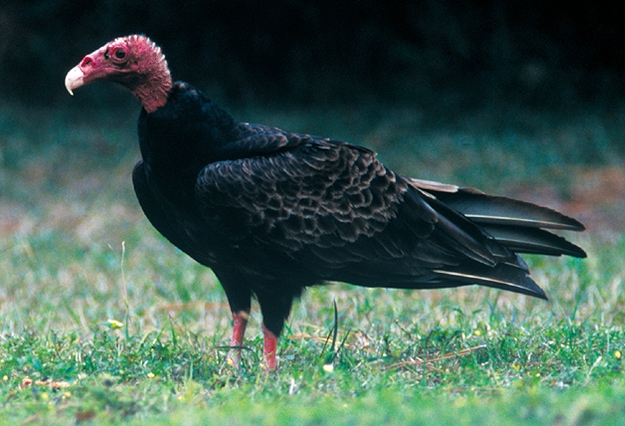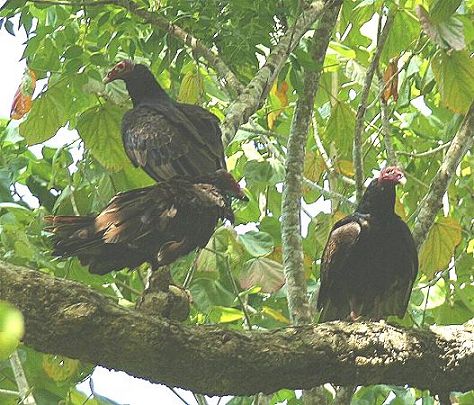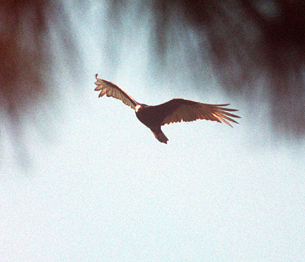|
Turkey Vulture Cathartes aura Aura Tiñosa,
|
 |
|
Photo: G. Beaton
|
|
IDENTIFICATION: A large, black soaring bird with a red head (gray in the first few months of life). The underside of the flight feathers flash a silvery reflection in the right sun angle. Length: 64-81 cm.; weight: 850-2,000 g.; wingspan: 180-200 cm. VOICE: Vultures lack the syrinx that other birds use to produce sound, but can hiss when disturbed. The only sound most people ever hear a vulture make is the noise their wings make as they take off. Audio (M. Oberle). HABITAT: Open grasslands, coasts, dry forest, pastures and farming country with nearby cliff, cave or treetop roosting areas. HABITS: Often seen soaring over open country as it looks for animal carcasses. To save energy, it glides on the lightest winds, or sometimes soars to great heights in rising hot air. It holds its wings in a "V" shaped (dihedral) angle that can be distinguished from far away. The vulture often rocks from side to side, as it maneuvers in the breeze. The feathers on the wingtips are often spread apart to reduce air turbulence and decrease the stall speed. Thus the bird can soar very slowly. It detects dead animals by sight or by smell, and will eat any dead animal: mammals, birds, reptiles, amphibians, fish----even dead crickets. It often hunts for carcasses alone, but as soon as one vulture homes in on a carcass, other vultures appear out of nowhere. Only one, or at most two, vultures feed at a time on a carcass, while other, less dominant vultures wait their turn or are chased off by the feeding bird. Vultures cannot cut through very thick animal skin, so they may have to wait for a dog or other animal to cut open a dead cow, or alternatively wait a few days for the carcass to start rotting before they can feed. The vulture can hop or run short distances, but its feet are weak, so it cannot pull a dead animal very far. This creates a dangerous situation when the carcass is a road kill in the middle of a highway. The crop in the vulture’s throat can expand and hold a large quantity of food. The vulture converts that food to body fat and can survive for weeks between meals. The Turkey Vulture roosts in flocks on exposed tree branches, caves, or cliffs, and can often be seen perched with the wings outspread to warm up on a cool morning. In the heat of mid-day, vultures can radiate excess heat through the naked skin of the head, and will also urinate on their legs to cool off. The nest is an unmodified rock ledge, cave, tree stump, or just a protected spot under dense shrubs. Vultures are thought to mate for life. Typically two eggs are laid, weighing about 80 g. each. Nest pairs alternate incubation duties over a 38-40 day period. The young start to make extended flights 70-80 days after hatching. Some mainland vultures have been documented to live 16 years in the wild. STATUS AND CONSERVATION: A common sight in the open country of southcentral and southwestern Puerto Rico. This species was introduced from Cuba in the late 19th Century, presumably to eliminate animal carcasses. It has benefited from the clearing of forest land for livestock. Vultures were sometimes persecuted by farmers who mistakenly believed that they killed livestock. Collisions with cars and towers are hazards to the vulture, especially during take off. As with many species of birds, the vulture will dive when approached by anairplane, but many human pilots will also dive when they see a vulture. Collisions result, with fatalities on both sides. Pesticide poisoning is a threat, e.g., DDT used to thin vulture egg shells before that insecticide was banned. Dogs can attack vultures at roost sites, and mongooses are thought to rob nests. RANGE: Breeds in the Greater Antilles, and from southern Canada south to Tierra del Fuego, and even the Falkland Islands (Malvinas). On a sunny day’s drive from Ponce to Cabo Rojo it is common to see a total of 50 or more vultures soaring over open country.
TAXONOMY: CICONIIFORMES; CATHARTIDAE |
|
 |
|
|
Photo: B. Hallett
|



